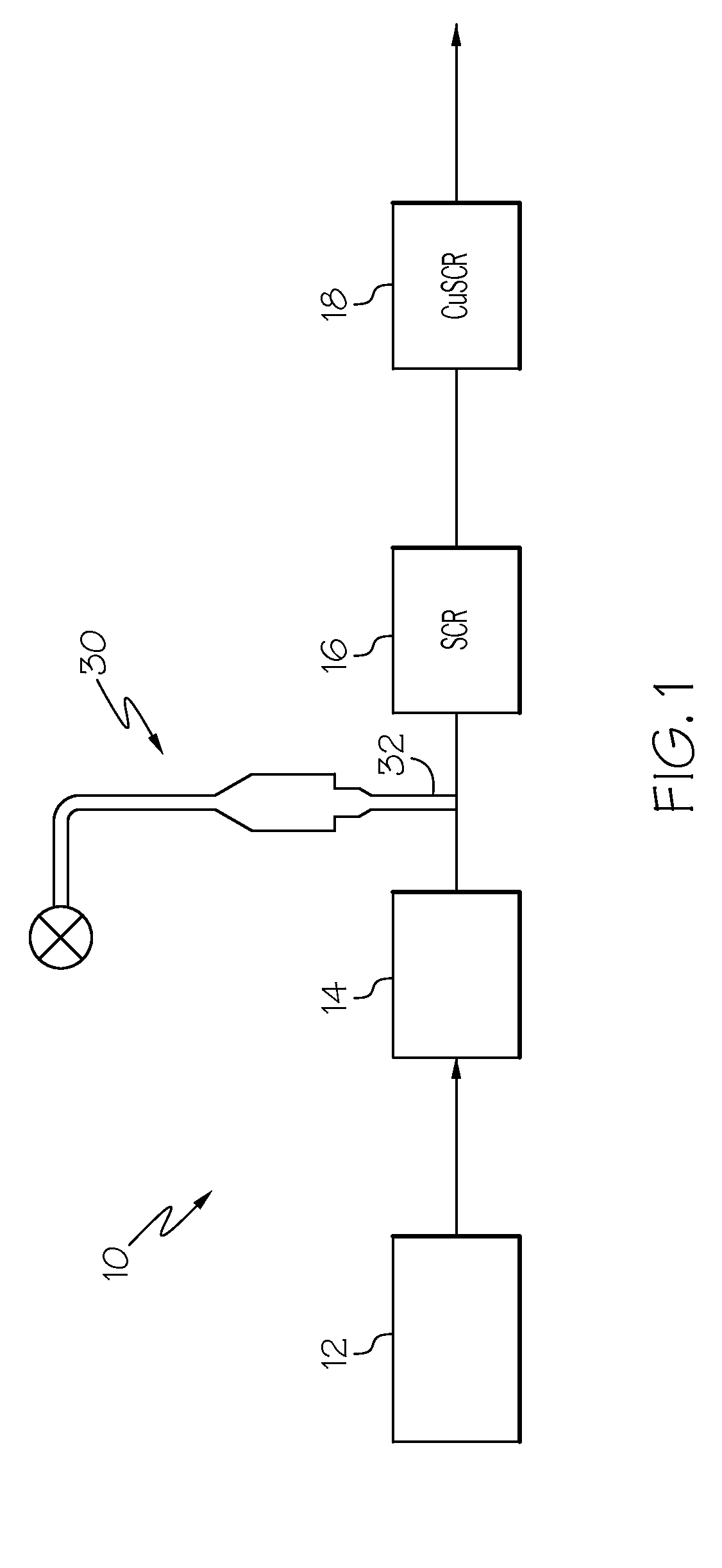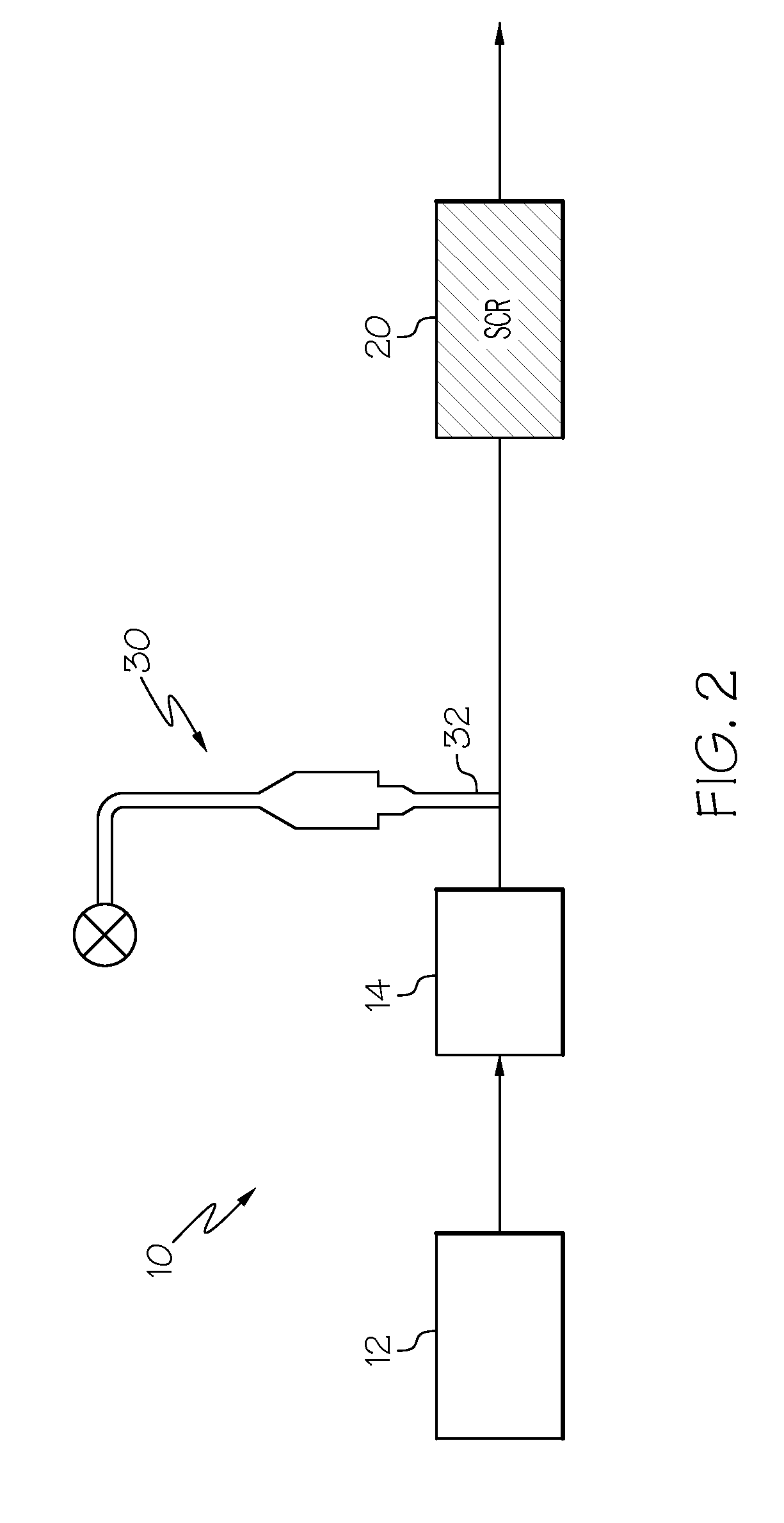IRON-ZEOLITE CHABAZITE CATALYST FOR USE IN NOx REDUCTION AND METHOD OF MAKING
a technology of iron zeolite and catalyst, which is applied in the field of preparation and use of iron zeolite catalysts, can solve the problems of increasing nosub>x /sub>production, sub>x /sub>reduction, and loosing activity of catalysts, and achieves good high-temperature activity
- Summary
- Abstract
- Description
- Claims
- Application Information
AI Technical Summary
Benefits of technology
Problems solved by technology
Method used
Image
Examples
example 1
[0040]Samples of iron chabazite were synthesized in accordance with the process described in detail above. Iron content was measured to be 1.2 wt % for both samples. One sample was ion exchanged with ammonium ion to convert the iron chabazite to an ammonium form. Sodium content was measured to be 6.3 wt % in the non-exchanged sample, while sodium content was 390 ppm after ammonium ion exchange. Both the Na and NH4 chabazite samples were then degreened for 4 hours at 750° C. Both samples were then tested using a simulated vehicle exhaust containing NOx. The samples were tested in a bench flow reactor employing a simulated diesel exhaust consisting of 13% O2, 5% CO2, 4.5% H2O, 350 ppm NO, 350 ppm NH3, and the balance N2. 3.0 grams of each sample was placed over a gas flow of 9.65 SLPM (standard liter per minute). This is equivalent to a space velocity of 30,000 / hr over a washcoated monolith. All components except for N2 and O2 were analyzed simultaneously by FTIR.
[0041]As can be seen ...
example 2
[0042]Three different samples of catalysts were prepared and tested. The first two samples were synthesized in accordance with the process described in detail above. Iron content was measured to be 1.2 wt % for both samples. Both samples were then ion exchanged with ammonium ion to convert the iron chabazite to an ammonium form. Sodium content was greatly reduced after ammonium ion exchange. Both chabazite samples were then degreened for 4 hours at 750° C. The second chabazite sample was then subjected to accelerated aging for 80 hrs. at 800° C. The third sample comprised a conventional copper-based SCR catalyst obtained from BASF which had been degreened for 4 hours at 750° C. All of the samples were then tested using a simulated vehicle exhaust containing NOx. The samples were tested in a bench flow reactor after an initial degreening at 750° C. for 4 hours. The simulated diesel exhaust consisted of 13% O2, 5% CO2, 4.5% H2O, 350 ppm NO, 350 ppm NH3, and the balance N2. 3.0 g of ea...
example 3
[0044]An aged iron chabazite catalyst prepared in accordance with an embodiment of the invention was tested along with a degreened conventional copper-based SCR monolith catalyst. The catalysts were tested separately and in combination, with the Fe chabazite pelleted catalyst positioned immediately upstream from the copper-based SCR monolith catalyst. The samples were tested in a bench flow reactor after an initial degreening at 750° C. for 4 hours. The simulated diesel exhaust consisted of 13% O2, 5% CO2, 4.5% H2O, 350 ppm NO, 350 ppm NH3, and the balance N2. 3.0 g. of the Fe chabazite pellets and a 1.18 in3 copper-based SCR monolith catalyst were placed over a gas flow of 9.65 SLPM, corresponding to a space velocity of 30,000 / hr over each component. All gas species except for N2 and O2 were analyzed simultaneously by FTIR. As can be seen in FIG. 5, at temperatures above 400° C., the performance of the combined Fe chabazite catalyst and copper SCR catalyst is superior to that of th...
PUM
| Property | Measurement | Unit |
|---|---|---|
| Temperature | aaaaa | aaaaa |
| Fraction | aaaaa | aaaaa |
| Fraction | aaaaa | aaaaa |
Abstract
Description
Claims
Application Information
 Login to View More
Login to View More - R&D
- Intellectual Property
- Life Sciences
- Materials
- Tech Scout
- Unparalleled Data Quality
- Higher Quality Content
- 60% Fewer Hallucinations
Browse by: Latest US Patents, China's latest patents, Technical Efficacy Thesaurus, Application Domain, Technology Topic, Popular Technical Reports.
© 2025 PatSnap. All rights reserved.Legal|Privacy policy|Modern Slavery Act Transparency Statement|Sitemap|About US| Contact US: help@patsnap.com



